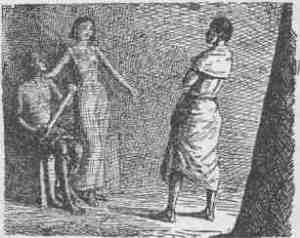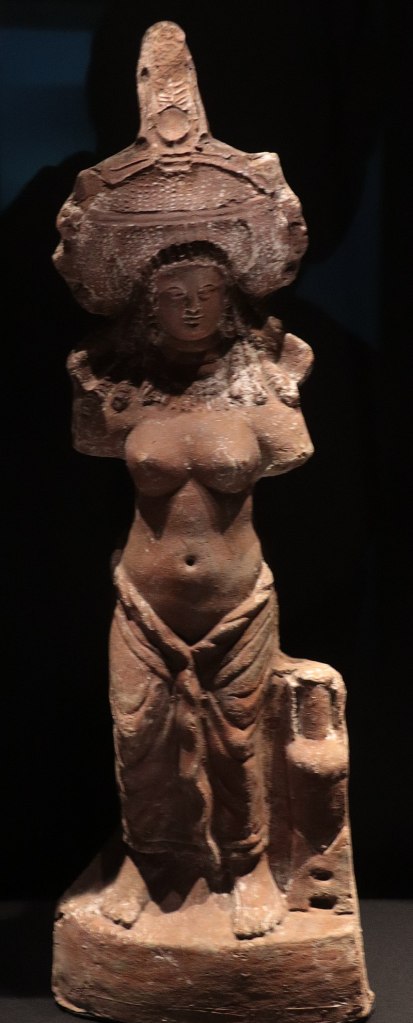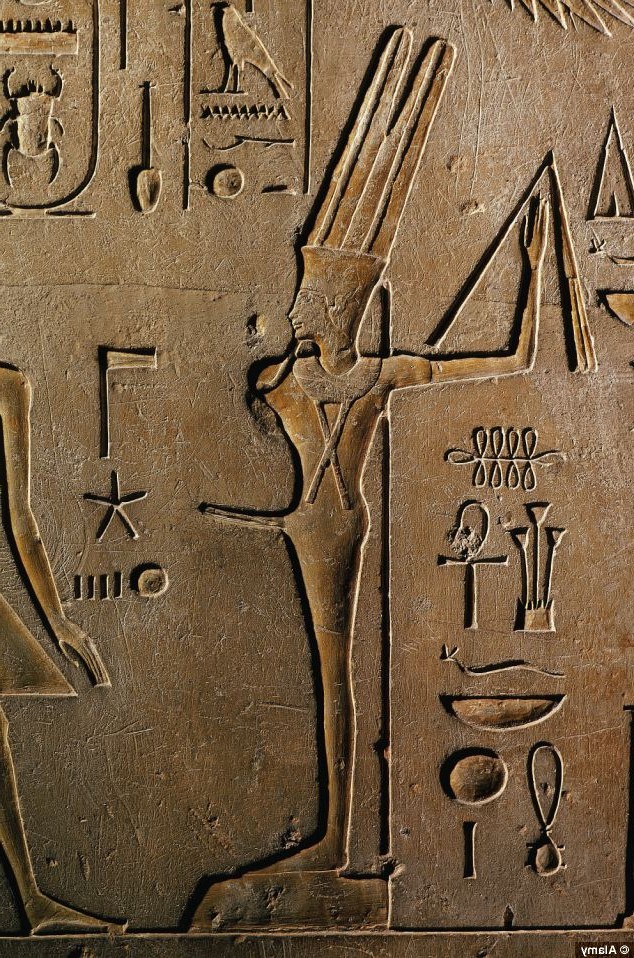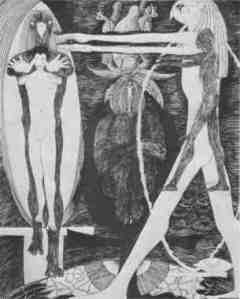Hail to Thee, Isis, Lady of the Star
If you’ve been following this blog, you know I write a lot about Isis as Lady of the Holy Star. In my area, Portland, Oregon, Her heliacal rising is a week from today.
I will be in my local high place (I am fortunate to have one near my home), awaiting Her reappearance with offerings in hand at 4:30 in the morning. I will watch as the Mystery unfolds and the Goddess emerges once more from the Underworld into the dawning light.
But for now, I watch the morning skies in anticipation of the pre-dawn reappearance of the beautiful and brilliant star of Isis, Sirius.
Thanks to the wonders of modern online astronomical calculators, we can know pretty precisely when the Fair Star of the Waters will rise before the sun in our area. (To use the calculator, just enter your email and the password: softtests. You will need to know the latitude and altitude of wherever you are observing Her rise. This info is easily google-able.)
If you want to know more about Sirius and Isis, here are some links to previous posts, all in one place:

The basic information on Isis and Her holy star and why it is called the “dog star”.
Meditations on Isis and Her Mother during this time of waiting.
The experience of my sister priestess and me one year as we watched Her rise.
About the symbol of the star in Egyptian spirituality and being “joined” to yours.
And a ritual for beginning the process of “being joined to your star.”
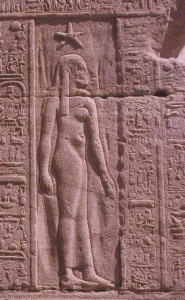
The rise of the Star of Isis was important in ancient Egypt for it marked coming of the fertilizing Nile Inundation and the day of the New Year. It was also the end of the epigominal days, those days out of time when the the Cairo Calendar tells us that the birthdays of Osiris, Horus the Elder, Set, Isis, and Nephthys were celebrated.
Thus, if you wish to celebrate the Birth of Isis, it is two days before New Year’s Day.
There are a number of options for choosing our New Year’s Day.
For instance, perhaps you’ve seen a date of July 19th given for the rising of Sirius? This comes from a 1904 calculation by Eduard Meyer, who was the first modern person to have noticed ancient Egypt’s Sothic Cycle.

You may recall that the Sothic Cycle is a period of 1,461 ancient Egyptian years during which the 365-day Egyptian year, which is one quarter-day too short, loses enough time so that the Egyptian New Year, once again coincides with the rise of Sirius.
Meyer was trying to calculate the date of the star’s rising from the ancient Egyptian calendar and translate it to the modern Julian so that the reigns of the pharaohs could be more accurately dated. The Sirius rising date he came up with was July 19—but that would have been for 140-142 CE.
You may certainly use that date if you prefer a firm date for planning your celebrations. That would make New Year on July 19th and Isis’ birthday on July 17th.
Personally, I like to use the date when Isis’ star may actually be seen in the morning skies in my area. You can use the calculator link above to find out when She rises in your area.

Another option might be to use the modern rising time at either of Isis’ major sacred temple sites in Egypt.
At Her Lower Egypt temple of Isiopolis in the delta, that was on August 8th this year.
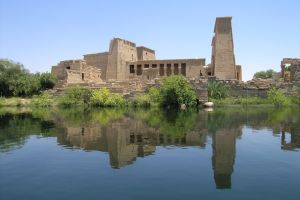
At Her Upper Egypt temple of Philae/Agilika, that was on August 2rd.
So you can see that latitude makes a great deal of difference as to when the rising of the Goddess’ star may be actually observed.
If you wish to join me in celebration of Her rising, you’ll need to be at your observation point about an hour before sunrise in order to see Her. We may chant Her name—Iset-Sopdet, Isis-Sothis—as She rises. We may offer Her milk and lotuses. Or we may watch in beautiful silence as She comes, She comes.
Miracles Archive
Miracles Archive
Isis Rising 2020
It is getting to be that time. That time when She rises early, early in the dawning light. This is known as the “heliacal rising of Sirius” and it’s the best thing that happens in August as far as I’m concerned. While everything else starts to crisp in the late summer heat, I am refreshed in Her rising power.
Now some of you may be saying, “wait, wait, I thought that happens in July.” It could. When you are able to see Her heliacal (“before the sun”) rising depends on where on this globe you are.
Here in Portland, Oregon in 2020, Sirius rises at 4:34 in the morning of August 22rd. Further south, She rises earlier. It all depends on your latitude, you see. You can calculate Her rising in your area with this online calculator. Then, if you’d like to celebrate Isis’ birthday, it would be two days before the rising of Sirius, in my case, August 20. So Isis is a Leo (at least at this latitude.) And well, She is Isis-Sakhmet, after all.
Of course, some people see Isis in the pale, magical light of the moon. Or in the golden, life-giving rays of the sun. I do find Her there, yes…
But for me, the heavenly body in which I most easily see Her is the star, Her star: Sirius (Sopdet in Egyptian, Sothis in Greek). And it isn’t just because of Her strong ancient connections with the Fair Star of the Waters, the Herald of the Inundation. It’s something about the way my particular spiritual “stuff” fits with Her particular Divine “stuff.” Her diamond starlight draws me, lures me, illuminates my heart and mind.
I fell in love with Her as Lady of the Star the first time I saw Sirius through a telescope. As I watched, Her brilliant star sparkled with rays of green and blue and pink and white. It was incredibly, unutterably beautiful. It was alive. And pure.
Likely, you already know why Sirius was important to the ancient Egyptians, so I won’t repeat that here. But I would like to add a few interesting bits about Sirius that you may not know about; in particular, the orientation of some Egyptian temples and shrines to Sirius at the time of their construction. For instance, the small Isis temple at Denderah and Isis’ great temple at Philae seem to have been oriented toward the rising of Sirius. Philae may even have a double stellar orientation: one axis to the rising of Sirius, one to the setting of Canopus.
Overall, Egyptian temples have a variety of orientations. A survey of temples taken between 2004 and 2008—that actually went to the temples in Egypt and measured the orientation—showed that most temples were oriented so that the main entrance faced the Nile. But not only that. It seems that the temples were also oriented toward other astronomical events, most especially the winter solstice sunrise, which of course makes very good sense as a symbol of rebirth.
Orientation to Sirius is rarer and harder to be certain of since the earth’s position in relation to the stars has shifted over the millennia.
A Horus temple, called the “Nest of Horus” on the summit of the highest peak of the Hills of Thebes, seems to have been oriented to the heliacal rising of Sirius around 3000-2000 BCE. Nearby, an inscription carved in rock during the 17th dynasty (1580-1550 BCE) records the observation of just such a rising of Sirius. This high place would have been ideal for Horus in His nest to await the coming of His mother Isis. On the other hand, the archaeoastronomers who did the survey I mentioned believe that it may also be oriented to the winter solstice sunrise, an event closely associated with Horus.
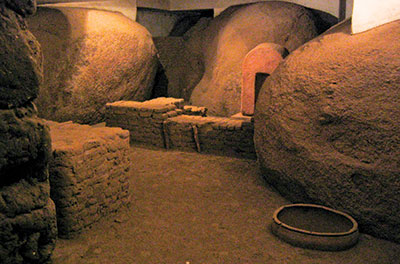
Another temple that may have a Sirius orientation is the archaic temple of the Goddess Satet on the island of Elephantine. The original temple was built amidst the great boulders on the island and really is quite simply the coolest temple ever. It seems that when it was built (around 3200 BCE) the rising of Sirius and the rising of the winter solstice sun were at the same place—so it could have been built to accommodate both important astronomical events.
After the initial study, the same team followed up with a survey (in 2008) of some temples in the Fayum that they hadn’t been able to study before as well as temples in Kush. They found generally the same results except for the Nile orientation since many of these temples were built far away from the river. They made note of a son of a Priest of Isis, Wayekiye, son of Hornakhtyotef, who was “hont-priest of Sopdet” and ”wab-priest of the five living stars” (the planets) and “chief magician of the King of Kush.” This is from an inscription on Isis’ temple at Philae dating to about 227 CE. It emphasizes the importance and sacrality of the study of celestial objects and events to the kingdom and it is quite interesting that this was the work of the Chief Magician. This study revealed that most Kushite temples and pyramids were oriented either to the winter solstice sunrise or the rise of Sirius.
Another interesting thing the study found was that by the time of the New Kingdom, in the 34 temples that were unmistakably dedicated to a Goddess—specifically Isis or a Goddess associated with Her—the most important celestial orientation point was the rising of Sirius. But, in addition to Sirius, the star Canopus was also a key orientation point. According to their data, Goddess temples in general were more frequently aligned with these very bright stars, Sirius and Canopus, while God temples were more often oriented to key solar-cycle events. Isn’t that interesting?

If you are, as I am, feeling the anticipation of Her rising later this month, you might like to do some ritual. The Opening of the Ways is always good. You could use it as an invitation to Her. Or try a simple meditation, allowing yourself to yearn for Her coming. Waiting for Her and wanting Her is sometimes a very good exercise. You might set out a vessel of water (a shiny silver one is nice) on the night of Her rising, let it be charged with that rising energy in the dawn, then use it as part of your holy water for purification. I have just such star water that I use waiting in my shrine right now.
Ahwere & the Magic Book
I was researching something else and was reminded of this Egyptian story. It’s a classic type of ancient tale. Yes, magic is involved. Isis and Thoth are involved. And dead people are involved.
It is usually called Setne and the Magic Book. It’s the one where the son of Rameses the Great, Setne Kaemweset, learns of a previous prince, Naneferkaptah, who aspired to magical knowledge and had discovered a magic book locked inside a series of chests and sunk in the bottom of the river. And now the son of Rameses, also a glutton for magical knowledge, wants it for himself.
I’d seen reference to that story again and again over the years, but I’d never read the whole thing. Turns out the tale is much more interesting than I’d thought. For one thing, the main story-within-a-story is being told by a woman, Ahwere, the daughter of King Mernebptah and wife of Naneferkaptah. What’s more, she’s dead when she’s telling it.
The tale has five separate sections: the story of how Setne gets the book, loses everything, has a strange adventure with the daughter of a priest of Bast, and eventually learns his lesson and returns the book.
For today’s Isiopolis, I’d like to tell you Ahwere’s tale. It comes from the Ptolemaic period, but as historical fiction, it refers back to a much earlier time. There is only one extant copy of this story. I’m using a translation by Flinders Petrie. The first part of the story is lost, but can be guessed from other information in the story.
Setne and his brother search for and discover the tomb of the former prince, Naneferkaptah, who was supposed to have this most amazing magical book. But when they get to the tomb, they find the kas of the prince, his wife, the princess Ahwere, and their child, Merib, quite present in the tomb. Ahwere warns them away from seeking the book of magic as she relates her tale:
The princess starts by explaining that she and Naneferkaptah were the only children of the king and he loved them both very much. When they were grown, the king decided to marry them to the children of one of his generals. But the queen objected and said the siblings should be married to each other.
The next paragraph is a bit unclear but is a bantering exchange between Ahwere and her father. Apparently Ahwere, too, wanted to marry her elder brother, Naneferkaptah, and had sent a message to her father saying so. He played grumpy, then they both laughed and Ahwere got her way.
She and Naneferkaptah were married. They loved one another and Ahwere soon became pregnant with their child. The king was happy and sent precious gifts. When Ahwere bore her child, he was named Merib, meaning Beloved Heart, and his name was registered in a book in the House of Life.
Naneferkaptah was very keen to learn from the ancient writings and spent much time reading in the Memphis cemetery and deciphering the sacred inscriptions on the monuments. One day, a priest saw him at his work and laughed at him. The priest said that what the prince was working so hard at was worthless compared to the magic book the priest knew of, which was written by Thoth Himself and which “will bring you to the Gods.”
The priest told Naneferkaptah that—quoting here—”When you read but two pages in this, you will enchant the heaven, the earth, the abyss, the mountains, and the sea; you shall know what the birds of the sky and the crawling things are saying; you shall see the fishes of the deep, for a divine power is there to bring them up out of the depth. And when you read the second page, if you are in the world of ghosts, you will become again in the shape you were in on earth. You will see the sun shining in the sky, with all the gods, and the full moon.”
Well, Naneferkaptah was completely excited and promised the priest whatever he wanted if only he would tell Naneferkaptah where the book was. The priest wanted enough silver so that he could have a rich funeral, a wish the prince readily and easily granted.
So the priest told him, “This book is in the middle of the river at Koptos, in an iron box; in the iron box is a bronze box; in the bronze box is a sycamore box; in the sycamore box is an ivory and ebony box; in the ivory and ebony box is a silver box; in the silver box is a golden box; and in that is the book. It is twisted all round with snakes and scorpions and all the other crawling things around the box in which the book is; and there is a deathless snake by the box.”
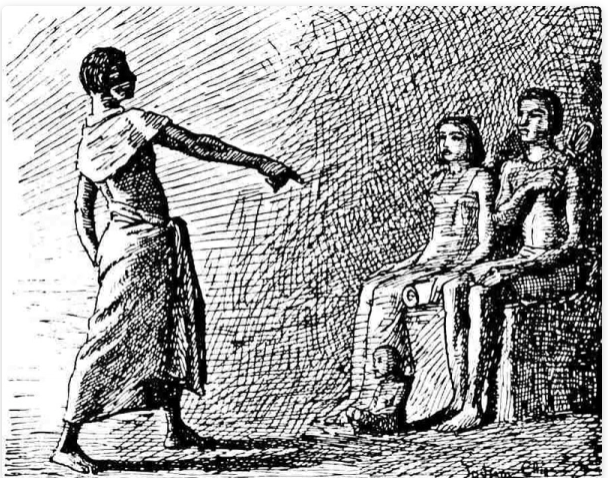
Then Ahwere says, “And when the priest told Naneferkaptah, he did not know where on earth he was, he was so much delighted.”
She, however, was not happy about her husband’s desire and felt a sense of foreboding. But the prince would not be dissuaded. Taking the royal boat, Ahwere, and Merib with him, the prince sailed to Koptos.
There was a temple of Isis in Koptos and so all the Isis priests came to meet the arrival of the royal boat. The priests entertained the prince and the wives of the priests entertained Ahwere. And so they feasted and “made holiday” with the priests of Isis and their wives.
After four days, the prince was ready to go after his prize. He had apparently learned enough magic that he could create a crew of magical workmen and tools from wax. The prince “put life into” the boat and crew and sent the magical workers off to find the book in the river.
This they did. The book was enclosed and guarded just as the priest had said it would be. Naneferkaptah put a spell on the magical guardians and fought the “deathless snake,” finally cutting him to bits and placing sand between the pieces so they could not rejoin.
The prince opened chest after chest, finally finding the book. He read it and—as promised—he could enchant the heavens and all the rest of the promised powers were his. So he had the magical workmen take him back to where Ahwere waited for him, in her words, sitting “like one who is gone to the grave.”
Now this next part, I found very interesting. Ahwere herself asks to read the book. She does so and she, too, can now enchant the heavens and has gained all the other powers as well. Ahwere can read, but she cannot write, which is needed for the next part of the magic. So she asks Naneferkaptah, who is an excellent scribe, to write everything on the book down on papyrus so that he could dip it in beer, then drink the dissolved words, and thereby know everything that was in them forever.
So back they go to Koptos and “make a feast with Isis of Koptos and Harpokrates.” But by now, Thoth had learned of the theft of His book and the killing of His magical guardians, which really kinda pissed Him off. So Re decrees that Naneferkaptah and all his kin could be killed. Ouch.
And so tragedy strikes. First the child Merib falls in the water and drowns. His father magically brings the body up and enchants the child so he can say what happened. Thus Naneferkaptah and Ahwere learn of Thoth’s anger. They return to Koptos, have their child embalmed and buried, and head back to Memphis.
But on the way back, the same thing next happens to Ahwere. She drowns, is magically brought up, then embalmed and buried in Koptos.

With such disaster befalling his family, Naneferkaptah could not return alive to his father, the king. Tying the book to himself, he drowns himself in the river. None of the crew knew where he was, so they returned to Memphis and related the entire sorry story to the king.
In mourning, the king and his court went to the boat, only to find the body of Naneferkaptah in the inner cabin of the boat—still dead—but at least available for proper rites and burial, which the king has done.
The king also orders the magic book hidden once more. Ahwere concludes, “I have now told you the sorrow which has come upon us because of this book.”
Oh course, Setne still wants the book (he is being quite unwise) and he contests with the ka of Naneferkaptah to get it. The ka of the great magician actually wins the contests, but with the help of the God Ptah and some additional magic, the brother of Setne (remember him?) brings Setne back.
The story of Setna and his further adventures with Naneferkaptah and Ahwere continue, but this post is long enough for now and I’ll tell that on another day.
There are a number of interesting things about this story. Importantly, it is told by a woman. She is no mere appendage, but a main player. We should also note that through Ahwere’s body is in Koptos, which is a LONG way from Memphis, her ka is still present with her husband in his tomb. It is also interesting that Ahwere can read, but not write. So even a princess did not necessarily learn to write. You can also see some of the main mechanisms of Egyptian magic: magical servants, magical guardians, consuming the words of a spell to integrate the magic into yourself, necromancy, and of course, the power-conferring magical book itself. It was also interesting to see the involvement of the priesthood of Isis and Harpokrates in Koptos. In my fantasy version of the tale, they would warn the prince of his coming folly. But I guess you don’t mess with a royal on a mission.
Chelanya, Festival of Regeneration
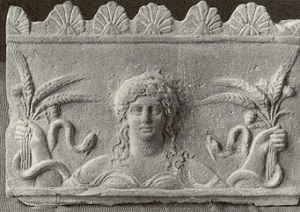 Chelanya, the Golden Festival, opens the Mysteries of Life season and is the festival of regeneration. Celebrated on the cross-quarter day of summer, it marks the beginning of the harvest season, symbolic of the bounty of Dea.
The image here is Ceres, the Roman mother goddess, with her particular motif of ripe grain. Note the snakes, also a symbol of regeneration from the shedding of their skin.
Read more about Chelanya, the Golden Festival
Chelanya, the Golden Festival, opens the Mysteries of Life season and is the festival of regeneration. Celebrated on the cross-quarter day of summer, it marks the beginning of the harvest season, symbolic of the bounty of Dea.
The image here is Ceres, the Roman mother goddess, with her particular motif of ripe grain. Note the snakes, also a symbol of regeneration from the shedding of their skin.
Read more about Chelanya, the Golden Festival Chelanya, Festival of Regeneration
 Chelanya, the Golden Festival, opens the Mysteries of Life season and is the festival of regeneration. Celebrated on the cross-quarter day of summer, it marks the beginning of the harvest season, symbolic of the bounty of Dea.
The image here is Ceres, the Roman mother goddess, with her particular motif of ripe grain. Note the snakes, also a symbol of regeneration from the shedding of their skin.
Read more about Chelanya, the Golden Festival
Chelanya, the Golden Festival, opens the Mysteries of Life season and is the festival of regeneration. Celebrated on the cross-quarter day of summer, it marks the beginning of the harvest season, symbolic of the bounty of Dea.
The image here is Ceres, the Roman mother goddess, with her particular motif of ripe grain. Note the snakes, also a symbol of regeneration from the shedding of their skin.
Read more about Chelanya, the Golden Festival Sexuality, Sacred Sexuality & Isis, Part 2
Last time we saw that there is no evidence for temple prostitution in ancient Egypt. Yet we still find modern writers (usually very well-meaning ones discussing sacred sexuality) who relay the tale that Isis spent ten years as a prostitute in Tyre, that She was beloved by prostitutes, and that Her temples were located near brothels and were reputed to be good places to meet prostitutes.
Where does all that come from?
Well, this is definitely one of those “consider the source” situations.
The bit about prostitution in Tyre is from Epiphanius, a 4th century CE Christian bishop writing against what he sees as heresies. He complains about the sister-brother marriage of Isis and Osiris then launches into the prostitution accusation. There’s no other evidence of this story circulating at the time. He may have made it up. He may have confused Isis with Astarte or even with Simon Magus’ muse Helena, who was a prostitute in Tyre (before being recognized by Magus as the “Thought of God” and the reincarnation of Helen of Troy and rescued from her life of prostitution by the magician; but that’s a whole other story).
The “tradition” connecting Isis with prostitutes and prostitution comes from a couple of sources; both worthy of clear-eyed consideration (see above). Cyril, Christian bishop of Alexandria in the 5th century CE wrote that “the Egyptians,” especially the women (shock! horror! faint!), when they were made initiates of the religion of Isis “are deemed worthy of honor—therefore of wantonness.” (On Adoration in Spirit and Truth, 9) But before him, a number of Roman poets and satirists made such claims in relation to devotion to Isis. Her temples were supposed to be fabulous places to meet loose women. And then there was the famous Isiac scandal, told by the Jewish historian Josephus, in which a Roman matron was supposedly tricked into going to the Temple of Isis so that “Anubis” could sleep with her.

When you look more closely into these accusations and put them in context, you see that the poets complained not only of temples of Isis, but of anywhere in Rome where women either gathered (the temples of a wide variety of Goddesses as well as just about any public space, for instance) or went to protect their interests (such as courts of law). If women are allowed to run around loose, lewdness is sure to follow.
It’s pure misogyny, folks. (One of these poets, the appropriately named Juvenal, wrote a poem called Against Women, in case I have not already made myself sufficiently clear.)
Without seeing the irony, several of these poets would write about sexual immorality and the temples of Isis, then turn around and complain when their mistresses would abstain from sex for a period of ten days as part of their devotion to Isis. (This period of abstention was known as the Castimonium Isidis or “Chastity of Isis.” Surely it was intended as a purification prior to some important Isiac rite.)
In fact, we have far more evidence for morality and chastity among Roman Isiacs than we do for sexual promiscuity. I’m sure it happened. Humans. Sex. But it wasn’t part of the temple proceedings.
So now we know. But that was Rome, and rather late. What about Egypt?
We know there were exuberant religious celebrations that included drinking and dancing in Egypt. In the 5th century BCE, Herodotus notes a celebration for Bastet in which boats full of men and women traveled to Bubastis, laughing, singing, clapping, rattling (sistra?) and playing flutes, the women hurling ritual abuse at other women along the riverbank and some raising their skirts to expose themselves to the crowd. The historian notes that more wine was drunk during that festival than all the rest of the year. You know there was some drunken sex going on. Surely this was a festival meant to inspire fertility in the land and in the people. I’ll bet it did, too. Festivals of drunkenness were also celebrated for Hathor. And a recently discovered and translated papyrus, dating back 1900 years, appears to be a fictional story about a devotee of Mut who seduces someone into joining the sexy, drunken festivities for that Goddess.
I’m not aware of a festival of drunkenness for Isis. The emotionalism associated with Her cult is the sorrow of lamentation—and eventually the joy of reunion with the Beloved.
Yet there is still good reason to think of Isis and sex. After all, She is one of the Deities to Whom one prayed for children; and naturally, one must take physical-world action along with one’s prayers. Furthermore, the story of Isis and Osiris has at its heart a sexual coupling. The Goddess magically resurrects Her husband in order that They may make love one last time and so conceive Their child, Horus.
A very unusual 2002 find at Osiris’ temple at Abydos may provide some information. It appears to be a votive offering and shows a woman and man having intercourse. Unlike most Egyptian representations of sex, it is neither crude nor satirical. The man is particularly well endowed, and in contrast to most male-female depictions, the woman is shown larger than the man. Because of the fragmentary nature of the carving, we can’t be sure what sexual position is intended, but it may be that she is straddling him. If so, then perhaps this is because she is intended to be in the Isis (or Nuet) position of woman-on-top.
Best guess is that it was a votive offering to promote fertility, even though such offerings were usually in the form of a phallus or a “fertility figure” (such as one of the big-haired wasp-waisted “paddle” dolls). There was a separate shrine of Isis at Abydos, but archeologists studying the votive have suggested that there might have also been an Isis shrine in the Osiris temple itself and thus the sexual votive would be even more appropriate. Sex is crucial to Isis and Osiris as well as to the Egyptian dead. Sex is part of the magic of renewal and rebirth. It is the magic Isis works with Osiris. It is the magic the Goddess in Her many names works for the dead. (See my post on Isis as a sexy Goddess here.)
In the early days of my relationship with Isis, one of the things She asked of me was that my lovemaking be given in Her name. Now, it could be that the researchers’ guess is correct and that the votive was an offering made to ask for fertility. But perhaps this unusual and somehow poignant votive offering was an expression of the same sort of thing that Isis asked of me so long ago. Perhaps it is a reminder that lovemaking is sacred, that it is a vital part of Isis’ magic of renewal, and that we should honor it as She does.
Bodies, Sexuality, Strength, and Badass Sorcery
I rarely post anything political on this blog. That’s not what it’s for. But sometimes—like when your city has been invaded by goon squads kidnapping citizens—it’s hard to write about anything else. And so, for a lead-in to today’s post about ancient Egyptian sexuality and Isis, I am proud to introduce you to “Naked Athena.”
THIS. This is why I love this city. This is the power of a vulnerable, naked human body. This is the power of Art.

Now, here’s another photo of the same kind of vulnerable power:

What is the difference between the stories of these two photos taken four years apart? Naked Athena was not arrested for her protest (nudity is officially illegal in Portland, but court rulings have made exceptions for protests). Ieshia Evans was. It is blatantly obvious that there’s a lot of justice work to be done, folks. Ma’et calls us to it and Black Lives Matter.
Deep breath.
Of course, we do not always use our naked and vulnerable bodies for powerful protest. And so today I also bring you…
Sexuality, Sacred Sexuality & Isis, Part I
If you’ve ever looked into the topic of ancient Egyptian sexuality, you’ll know that they were pretty comfortable with sexuality. Sex was part of the great cycle of creation, life, death, and rebirth. You’ve no doubt read some of the famous ancient Egyptian love poetry with passionate lines like these:
“Your love has penetrated all within me, like honey plunged into water.” “To hear your voice is pomegranate wine to me—I draw life from hearing it.”
As well as some that are an appreciation of the sheer physical beauty of the beloved:
“Sister without rival, most beautiful of all, she looks like the star-goddess, rising at the start of the good New Year. Perfect and bright, shining skin, seductive in her eyes when she glances, sweet in her lips when she speaks, and never a word too many. Slender neck, shining body, her hair is true lapis, her arm gathers gold, her fingers are like lotus flowers, ample behind, tight waist, her thighs extend her beauty, shapely in stride when she steps on the earth.”
We have such poetic passion from the perspective of both the woman and the man. Before marriage, young men and women seem to have had freedom in their love affairs. After marriage, fidelity was expected, though it went much worse for the woman—including death—if she was caught in infidelity.
The ancient Egyptians present a puzzling picture when it comes to homosexuality. On one hand, we have copies of the negative confession in which the (male) deceased declares that he has not had sex with a boy. Because he had to declare it, can we assume that some men were having sex with boys? That I do not know. The only reference to lesbianism comes from a dream-interpretation book in which it is bad omen for a woman to dream of being with another woman. And most references to man-on-man sex refer to the rape to which a victor may subject the vanquished enemy.
And yet we have two instances of what seems to indicate a consensual homosexual relationship that seem to be okay: King Neferkare goes off with his general and it is implied that they do so for sex. We also have the tomb of what used to be called The Two Brothers. More modern researchers have suggested that the men, who were royal servants and confidents, were a gay couple. This is based on their tomb paintings, which show them embracing each other or in placements usually reserved for a husband and wife. The men are shown with their children, but their wives, the mothers of the children, are very de-emphasized, almost to the point of being erased. Some scholars say, yes, they probably were a gay couple, other say no.
Yet I want to talk not about ancient Egyptian sexuality in general, but about sexuality and religion, and especially sexuality in relation to Isis.
Temple Prostitution? Nope.
First, let us put the whole “temple prostitutes” thing right out of our heads when it comes to Egypt. There is no evidence of the practice in Egypt. Yes, I know. It was very exciting for the old gentlemen to contemplate the ever-so-Pagan goings on in those richly colored temples in days of old. But it may not have been quite how the old gentlemen envisioned it. (Please see my kindly rant on the old gentlemen of Egyptology here.) In fact, the one specific reference comes from the Greek geographer and historian Strabo (64 or 63 BCE-24 CE). Here’s the passage in its Loeb 1930s translation:
“…but to Zeus, whom they hold highest in honor, they dedicate a maiden of greatest beauty and most illustrious family (such maidens are called ‘pallades’ by the Greeks); and she prostitutes [or “concubines,” pallakeue] herself, and cohabits [or “has sex” synestin] with whatever men she wishes until the natural cleansing of her body takes place; and after her cleansing she is given in marriage to a man; but before she is married, after the time of her prostitution, a rite of mourning is celebrated for her.” (Strabo, Geographies, 17.1.46)
Well, it’s right there, ain’t it? But let’s take another look. The keys are the Greek word pallades that Strabo says the Greeks called such maidens, its relation to another Greek word, pallakê, and how it was translated, and the old gentlemen who did the original translating.
Pallades means simply “young women” or “maidens.” As in Pallas Athena. Virginity is often implied, but it doesn’t have to be. Pallakê originally meant the same thing; a maiden. However, pallakê had long been translated as “concubine” due to contextual evidence in some non-Egyptian texts. A highly influential scholar of near eastern and biblical texts, William Mitchell Ramsay—one of our old gentlemen, indeed—took the term to mean “sacred prostitute” and so-translated it when he first published these non-Egyptian texts in 1883. He based the translation on his own belief in ancient sacred prostitution and two Strabo passages: one about Black Sea sacred prostitutes and the one about the pallades we’re discussing. Ramsay was so influential that his definition became the reigning one. THE Greek-English dictionary, by Liddell and Scott, had “concubine for ritual purposes” as the first definition of pallakê. Now it is the second one.
A non-sexualized translation of the Strabo passage has been made by Stephanie Budin in Prostitutes and Courtesans in the Ancient World, edited by Christopher Farone and Laura McClure. Here it is:
“But for Zeus [Amun], whom they honor most, a most beautiful maiden of most illustrious family serves as priestess, [girls] whom the Greeks call ‘pallades’; and she serves as a handmaiden and accompanies whomever (or attends whatever) she wishes until the natural cleansing of her body; and after her cleansing she is given to a man (or husband); but before she is given, a rite of mourning is celebrated for her after the time of her handmaiden service.”
Sounds quite different, doesn’t it? Would it not be more likely that a highborn girl who has not yet had her period would serve as a handmaiden in the temple, attending whatever rites she wishes—perhaps even getting an education—until she proves herself marriageable by having her first period, rather than expecting an inexperienced girl to immediately start having sex with “whomever she wishes”? (And who would that be in the temple; the priests who were required to abstain from sex during their temple service?) Even the “rite of mourning” is explicable as a kind of farewell to childhood that the young woman would celebrate with her fellow handmaidens and priestesses as she left the temple to take up her married life.
What’s more, sex in an Egyptian temple was taboo. Even Herodotus knew of the prohibition against sex in Egyptian temples when he says that the Egyptians were the first to make it a matter of religion not to have sex in temples and to wash after having sex and before entering a temple. (Histories, 2.64)
Alternatively, Budin wonders whether Strabo might have been hearing stories about the Divine Adoratrice or God’s Wife of Amun, powerful and high-ranking priestesses of the centuries before Strabo’s visit. But at least in the later dynasties, these priestesses were celibate and tended to rule long past their first menstrual period.
Sacred Sexuality? Yep.
Well. This post is long enough for today—and haven’t even gotten to Isis yet. So we’ll do that next time with more on sexuality in Egyptian religion…and we will indeed get to Isis.
Big Magic: Communing with Goddess Isis
The Key to Egyptian Magic, Part 3
We’ve been talking about what I call (for lack of a known ancient Egyptian term for it) Kheperu, “Forms” or “Transformations.” It is a way of taking the imaginal Form or Image of a Deity upon ourselves and—for a specific, limited period—thus Transforming ourselves into the Deity; in this case, Isis.
It’s not exactly the same thing as trance possession or “being ridden” by a Loa, as in Voudon. In the case of Kheperu, the ritualist does not lose their own consciousness. Rather, consciousness is expanded. Assuming a Kheper (sing.) is more like stepping into a stream of Divine power, more like being carried than carrying.
When successfully done, Kheperu puts us in touch with a deeper wisdom that serves as guide in any act of magic, mundane or spiritual. It means no more—and no less—than placing the Divine part of ourselves in contact with a greater Divine power. In this way, we “become” the Goddess. The potential that this offers for spiritual development as well as for practical magic is immense.

People differ in what they believe a Kheper or—as it is often known in modern ceremonial magic—a God/dessform is. Some consider it to be a purely human psychological construct. Some consider the imaginal Form to reflect an archetype, which in turn, reflects a Divine Reality. Most will consider a Kheper to be a little of both—a sacred and enlivened image to which both humanity and Divinity contribute.
I’ve seen some folks using the term “Godform” in a way that suggests that the Form is somehow the whole Divine Being; that “Godform” is just another, perhaps more technical, word for God. Nope. The Form is just that: a form. It is an interface that human beings can use to connect with some part of the Truth of a Deity. I’ve also seen some criticism of using the term “energy” to talk about what we sense in the presence of a Deity as being a bit too new age-y. However, I find it a useful metaphor, so I’m going to continue using it. Feel free to substitute your preferred term if it’s not to your liking.

To me, a Kheper is an image that interprets the Divine energy of a particular Deity or aspect of the Deity to us as human beings. Normally, it would be an image that has some history behind it, an image that has been invested with human spiritual, mental, and emotional energy for hundreds or even thousands of years. When it comes to Isis, we may picture Her in any number of ways that artists have portrayed Her during the thousands of year of Her worship.
To use Jungian terms, we can think of a Kheper as an image recorded in the Collective Unconscious. By assuming the Form, we make it conscious rather than unconscious. These images live by virtue of the energy, both Divine and human, invested in them.
Like the ancient Egyptian who dons the cloak of the Great Lady and becomes the Great Lady, we, as modern devotees, can also put on the cloak or Form of the Goddess and “become” Isis. An invocation of Isis by the technique of Kheperu is a great, sacred cycle of inflowing and outflowing energy, from human to Divine, Divine to human.
If we succeed in doing this, we will certainly know it—for the feeling is very unlike any normal state of consciousness. We may feel as if our body, soul, mind, and spirit have tapped into a stream of power coming from outside ourselves, a stream which extends beyond the physical and touches invisible realms. We may perceive ourselves as enormous, towering over the earth or suspended in space. We may have a feeling of expansion in the heart or little rushes or spasms of energy throughout the body. We will feel the intense presence of Isis and may participate in the creativity and magic that are an essential part of Her nature. Through the Kheper of Isis, we will be able to use some of the power of the Goddess Herself to initiate, empower a rite, charge a talisman, or commune with Her.
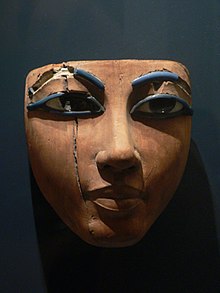
Big Magic Caveats
With Big Magic like this, there are always caveats. If you are reading this blog, I will assume that you have some form of devotional relationship with Isis. That’s good. If not, you might wish to develop one before doing this rite. (That’s not to say you can’t take on the Kheper of a Deity you don’t have such a relationship with, just that it will be easier and more productive if you do.)
I probably don’t have to tell you this, but we do not Become the whole Goddess with this technique; rather, we help our own divinity blossom into a little bit of Her. The great Neoplatonist teacher Iamblichus discussed this in relation to theurgy. I’m paraphrasing now, but he tells us that with this technique, we maintain a dual perspective: we are both in touch with Deity and aware of our own natural human place in the world. We know both at once—just as in the Coffin Texts example from last week.
And remember, when we’re doing ANY magical Work, we are always using the only tool we have: ourselves. We are human beings and we come with a full complement of psychological shit packed into our heads and hearts and souls. The more we are aware of our own psychology and as we work to heal what we need to heal, the more we can separate what is our own stuff from Hers. Indeed, Divine contact like this can be part of the therapeutic process. Since Isis is alway ma’et, Right and True, when we align ourselves with Her in this way, we become more ma’et, too.

What’s more, in this process, we will discover that true Divine contact, though very powerful, is humbling and does not idly flatter the ego. We may come to believe, as did the theurgists and Hermeticists of old, that the Divine Ones participate in our assumption of Their Forms not merely because of the ritual or Their harmony with the images, symbols, and names employed, but because of Their Goodness and Divine Love for us. We will see that when we expend our effort to reach out the Them, They will in turn stretch out Their hands to us, guiding us, assisting us in our magic, and most importantly, helping us grow spiritually.

The following rite, Becoming Isis, is from Isis Magic and envisions Isis in Her role of Lady of Heaven, Earth, and the Underworld. If Kheperu is a new technique for you, Isis is an excellent choice as She will be indulgent and kindly as you learn. When you work this rite, you may or may not have success the first time. Either way, it’s okay. Just keep coming back to it. Use your sacred imagination to visualize the image and the energy. Breathe. Take your time.
Prepare yourself with a ritual bath or other purification of your choice. Make sure you have an opening and closing ritual ready. If you’re using Isis Magic, try any of the rites suggested in the rubric below. If not, do whatever you would normally do to open a ritual, such as casting a circle and calling the Quarters.
Becoming Isis
Enter the temple and face east. Still yourself by breathing the sequence of the Breath of Isis (or just breathe slowly and deeply) until you are calm and focused. Perform the Four Pillars of the Earth, the Star of Isis, or the Opening of the Ways to open the temple. At the midpoint, begin your invocation:
Ritualist: I invoke Isis, the Giver of Life, Who pours out the Inundation, She Who makes green plants grow and all people live. I call upon Isis the Ever-Living, Who offers Her abundance to all the souls of earth. I ask You, Isis, Lady of Heaven, Lady of Earth, Lady of the Otherworld, to come. O Lady of All Who brought all things into existence through what Her heart conceived and Her tongue spoke into Being, come to me. Come, You Who are the Living Soul of Everything, come to this, Your temple, and to me, Your Child. Let me take on Your Kheper, Your Form, O Goddess Isis the Great. Let me be Your garment.
(Vibrating) ISIS! ISIS! ISIS!
Be seated in a comfortable, meditative posture and close your eyes. Visualize the form of Isis as described in the speech that follows. Imagine the Goddess as very large, with Her feet in the Underworld and Her head in the Heavens. Next, visualize yourself growing larger and larger. Notice how your perceptions of the world change as you grow. When you are almost, but not quite, the same size as Isis, turn to face Isis and look into Her eyes—if you can. Bow in respect, then turn so that the Kheper of the Goddess is once again behind you.
Now, imagine stepping backward into the Kheper of Isis. The face of Isis is before your face. The wings of Isis are upon your arms. The heart of Isis surrounds your heart. The body of Isis envelops your body. The feet of Isis uphold your feet. Through an act of will, now let yourself expand to completely fill the Kheper of Isis.
Ritualist: (When ready, speaking in the Kheper of Isis, as Isis) I am Isis. My Form is that of a beautiful woman with shining Wings. I am crowned with the Crescent of the Moon and the Disk of the Sun, and above them rises a Star that rests upon the image of My Throne, for I am Queen of Heaven. In my right hand I bear the Lotus Wand with which I enliven all of nature. In my left, I bear the Ankh, for I am the Mother of Life and the Lady of Re-birth. Light pours forth from My Form.
I am the Great Goddess. I am called Isis the Divine and Lady of Words of Power. I am Isis the Magician. I am the Movement Around the Still Point. I am the Form and I am the Ritual. I am the Shaper of the Forces. I am the Goddess Throne, Maker of Kings and the Seat of All Being. Through knowledge of Me, My Devoted Ones learn to guide themselves with Wisdom.
I am the Light-giver of All. I am Isis.
Allow as much time as you desire to experience the energy and presence of Isis. You may receive a greater understanding of Her nature. You may see visions from the point of view of the Goddess. You may hear the words of the Goddess in your mind. All these things are experiences of the energy of Isis. When the experience is complete, end the vision by thanking Isis.
When you are ready, take off the Kheper of Isis by reversing the procedure for taking on the Form. Visualize yourself growing smaller so that you no longer fill the image of Isis. Step forward out of the Form, feeling your separation from the image of the Goddess. When you have fully separated, turn to face the Goddess and bow in respect. Then allow yourself to continue becoming smaller until you return to your human size. Become aware of your human size, shape, and the feeling of your own human energy. Open your eyes and come back to yourself.
Ritualist: I thank You, Isis, the Giver of Life, Who pours out the Inundation. Isis, Who is the Living Soul of Everything. I thank You for allowing me to take on Your Kheper, Lady. I thank You for letting me be Your garment and for receiving this glimpse of Your Divinity.
Be in Peace, Goddess.
Amma, Iset [Ah-MA, Ee-SET; ancient Egyptian for “Grant it, Isis”].
Close the rite in the manner appropriate for the opening, then quit the temple.
I hope you will share with me your experiences with the Kheper of Isis. Be blessed beneath Her wings.
Big Magic for Hard Times, Again…

The Key to Egyptian Magic, Part 2
Last week, we talked about Kheperu or “Transformations” as the key to Egyptian magic. This is the technique by which a human magician, priest/ess, or other adept practitioner, may briefly partake of Divine powers through the use of sacred images, ritual speech, and right action. It is a way of empowering our magic.
To develop this technique, a society would need to understand that human beings could become godlike—which ancient Egypt did—and further, that human and Divine beings naturally interact with each other and mutually affect each other.
This is a magical and participatory world. In Jeremy Naydler’s book The Temple of the Cosmos, he comments that the Egyptians believed human beings depended on the Deities, but that the Deities also depended on human beings—even to the extent of relying on human action to help mobilize heka (“magic”) in the universe through the temple rites. Both Deities and humanity must uphold Ma’et (“Rightness,” “Truth”) or the universe will be thrown into chaos. Thus human beings have an innate power and influence, although we cannot hope to match that of the Goddesses and Gods. In this world view, it is theoretically possible for a human being—especially one who had acquired a lot of heka, because one can acquire it—to cause change or even chaos in the universe. If humans are part of the universal order, we can affect the universal order.
This interconnectedness is why we sometimes find threats made against the Deities in Egyptian magical formulæ. This was one of the things that freaked out Greek magic workers when they encountered it. To them, claiming godlike power was hubris—and the Gods were sure to smack you down for it rather than help you out.
Nuet, the Heavens, joined to Geb, the Earth
Yet the idea that human beings have the power to affect the universe stems from the interrelatedness and interdependence of the human and the Divine worlds in Egyptian tradition. In the same way that the Great Goddess of Magic, Isis, threatens to stop the Boat of the Sun in its tracks unless Her son Horus is healed, so the human magicians sometimes threatened the Deities with a similar upset to the cosmic order unless their desires were met. “The expertise of the magician lay in bringing together the spiritual and material levels in a deliberately engendered and powerful coalescence. Magic did not function exclusively on the physical or the psychic or the spiritual planes but on all three together,” writes Naydler. And a most effective way of joining all three worlds is through the technique of Kheperu.
Some Examples of Kheperu
In his excellent study, Conceptions of God in Ancient Egypt, the One and the Many, Egyptologist Erik Hornung defines Egyptian Deities by three criteria: Onoma (the name of the Deity), Logos (words or knowledge about the Deity), and Eidolon (the image of the Deity). All three, combined with ritual, are also used in Kheperu as we see it expressed in Egyptian texts.
A longish passage from the Coffin Texts illustrates these principles and highlights some of the characteristics of Kheperu (CT Formula 484, Faulkner translation):
“The Sistrum-Player is in my body, the pure flesh of my mother, and the dress will enclose me. I don the dress of Hathor, my hands are under it to the width of the sky, my fingers are under it as living uraei, my nails are under it as the Two Ladies of Dep, and I kiss the earth, I worship my mistress, for I have seen her beauty. She creates the fair movements which I make when the Protector of the Land comes; the gods come to me bowing and praise is given to me by the gods, they see me at my duty, and I am initiated into what I did not know, I cross the retinue of this Great Lady to the western horizon of the sky, I speak in the Tribunal. [. . .]
“The god who protects the land comes,” say the horizon dwellers concerning me. “The god comes, having gone aboard the bark,” say they who are about the shrine, who sit in the sides of the bark, who eat their food. They see me as the Sole One with the secret seal. I don the dress, I wear the robe, I receive the wand, I adorn the Great Lady in her dignity. Her Sistrum-Player is on her lap, and he has built mansions among your great ones, he has presented offering cakes, so that he may live thereon and that he may celebrate the monthly festival in his hour in company of those who are in linen, for he has looked at his face. So says the occupant of the throne of the Great Lady concerning me.”

We can be sure that the deceased is intended to be in the Kheper of Form of the Goddess because when he “dons the dress of Hathor,” “the Sistrum-Player is in my body,” and it is She Who “creates the fair movements which I make,” and the horizon dwellers “see me as the Sole One with the secret seal.” He employs the Onoma, the names and epithets, of Hathor in his formula. He has knowledge of Her Logos for he describes Her place in the sacred barques of the Gods. He also uses Her Eidolon, symbolized as the dress of Hathor, building up the Goddess’ image through the description in the text and putting on Her dress or image.
As in this example, Kheperu is often characterized by a multiplied consciousness. Here, the deceased perceives as a human being, as Hathor, and as Her son, the Sistrum-Player. The deceased is at once the Great Lady, Her Divine Child, and Her worshipper. So can we be both human being and Divine Being, mediating between Heaven and Earth, partaking of and blending both.
Another excellent example is a Coffin Text formula “for the Soul of Shu and for Becoming Shu” (CT Formula 228, Faulkner translation):
“I am the soul of Shu the self-created god, I have come into being from the flesh of the self-created god. I am the soul of Shu, the god invisible of shape, I have come into being from the flesh of the self-created god, I am merged in the god, I have become he.”
In the rest of this formula, the magician spends considerable time making statements that identify them with Shu. The magician recites the full myth of Shu, and beautifully ends the formula with “I am invisible of shape, I am merged in the Sunshine-God.”
In the following example, the deceased is identified with Re, quality by quality—which allows ample ritual time for visualization (Book of the Dead, Formula 181, Faulkner translation):
“His sun disk is your sun disk;
His rays are your rays;
His crown is your crown;
His greatness is your greatness;
His appearings are your appearings;
His beauty is your beauty. . .”
In Formula 78 of the Book of the Dead, the deceased says:
“Horus has invested me with his shape [. . .] I am the falcon who dwells in the sunshine, who has power through his light and his flashing. My arms are those of a divine falcon, I am one who has acquired the position of his lord, and Horus has invested me with his shape. “
Once the Kheper is assumed, the Deity could be perceived within: “Hail to you, Khopri within my body” states Formula 460 in the Coffin Texts.
I have no doubt that if you worked these spells today—as written and while in the proper frame of mind—you could indeed assume the Form of Hathor or Shu or Re or Horus…or, importantly for us, of Isis.
This is really a huge topic and, once again, I have taken up enough of your time for today.
One of the most important things about this technique is that it persisted. From ancient Egypt to the magic of the Greco-Egyptian Magical Papyri to the Hermetica to early Christian magic to Medieval magic to Qabalah and Christian mystics to modern ceremonial magic, Kheperu is there. And it is there because it works.
Big Magic for Hard Times
The Key to Egyptian Magic, Part 1
I admire the blogging work of John Beckett on Patheos. His recent post talks about the period of disruption we are in right now, which he (and some of his compatriots, I gather) call Tower Time, after the tarot card.
In this particular post, I was struck by his recommendation to magic workers to “take your magic up a notch” in response to current times. I do agree. As I said a couple weeks ago, this time of change, this time of flux, is precisely when magic can have an outsized effect.
So today I’m going to start a series on what I believe is THE key to Egyptian magic. It has no known Egyptian name, but you find it everywhere throughout Egyptian sacred written materials. It freaked out the Greeks when they learned about it from Egypt. And it still freaks out some modern magic workers.
Here, let me demonstrate it:
I am Isis. I have gone forth from my house and my boat is at the mooring rope… O you who travel in the sky, I will row him with you, I will travel as Isis.
My name is Isis in the Sealed Place; I am in my name and my name is a god; I will not forget it, this name of mine.
I am Isis when she was in Chemmis, and I will listen like him who was deaf and who stared.
Go behind me for I am Isis!
These excerpts from the ancient Egyptian Coffin Texts show the technique precisely. Of course, those texts can often be a bit obscure. Here’s another example of the technique in a modern Neo-Pagan/Witchcraft/Wiccan context:
Cool moonlight streams into the Circle, falls upon the altar, glitters the silver jewelry upon the breast of the High Priestess. Her eyes are closed. Her arms and legs are flung wide—as if she would abandon her body by sheer human desire. She feels her heart radically alive. She breathes softly and deeply, praying in silence for the Goddess to come, to come.
Before her, the High Priest kneels, “I invoke Thee and call Thee, Mighty Mother of us all, By seed and root, by bud and stem, by leaf and flower and fruit, by life and love do I invoke Thee to descend upon this Thy servant and Priestess!”
The witches begin a low humming as the High Priest continues to invoke the Moon Goddess by Her many names, asking Her, praying Her to descend—now! now!—into the body of Her Priestess.

Then a sharp intake of breath. The High Priestess’ breathing has become ragged. Moonlight catches in her hair, illuminates her body. An electric thrill runs up her spine. The nape of her neck prickles with spirit fire. Her hair stands on end. Her dark eyes snap open, staring strangely. The atmosphere within the Circle is changed. Every one of us feels it. Excitement in the pit of the stomach. Anticipation. Truth.
The High Priestess looks into our eyes, into our hearts, and begins to speak the Charge of the Goddess, “Whenever you have need of anything, once in the month, and better it be when the moon is full, then shall you assemble in some secret place to adore the spirit of Me, Who am Queen of all the Witches…”
We have Drawn Down the Moon. The woman who was our High Priestess is—for this brief and sacred moment—the Goddess incarnate. And She gives us Her blessings.

Drawing Down the Moon
The name of the modern ritual practice of Drawing Down the Moon comes to us from ancient Greece, when it was a known practice of the famous Thessalian witches. The ritual was well known in even the highest intellectual circles of Greek and Roman society. Plato mentions it as do Lucan and Horace.
We have no evidence that the ancient practice was similar to the modern one. The scant clues we do have suggest that it was not. Nonetheless, the modern rite is not without ancient precedent. It is simply to be found somewhere else—in texts, some of which, are roughly contemporary with the height of the activities of the Thessalian witches: the Greco-Egyptian Magical Papyri. This collection of ancient magical workings is usually known as the Greek Magical Papyri (PGM) because they are written largely in Greek. Nonetheless, scholars are generally agreed that much of the magical technique to be found in them is Egyptian. (Yes, I’m finally getting to Egypt.)
As I said, we don’t have a sure Egyptian name for this powerful magical technique. I have called it Kheperu, “Transformations” or “Forms.” The Egyptian root of the word means “to be, to exist, to form, to create, to bring into being, to take the form of someone or something, and to transform oneself.”
Recognizing Kheperu
It’s relatively easy to tell when we are witnessing the technique of Kheperu. Most simply, whenever we find the deceased, the priestess, or the magician claim TO BE a particular Goddess or God and speaks in the first person, we are likely to be witnessing Kheperu. It is the voluntary taking on of the astral or imaginal form of a Deity that enables the ritualist to share, albeit briefly, in the powers and Divine energy of that Deity, usually for the purpose of enhancing the effectiveness of a ritual or for deep communion with that Deity.
A clear example comes from a Coffin Text about the Goddess Hathor. The deceased says:
I am in the retinue of Hathor, the most august of the Gods, and She gives me power over my foes who are in the Island of Fire. I have put on the cloak of the Great Lady, and I am the Great Lady. I am not inert, I am not destroyed, and nothing evil will come to pass against me.
The deceased “puts on the cloak”—the imaginal or astral form—of Hathor and becomes Hathor. Doing so enables him to use Her power to protect himself in the Land of the Dead.
The Egyptian Concept Behind Kheperu
There is a basic idea that must exist in a culture to make it possible for the idea of Kheperu to develop—and that is that human beings are not divorced from the Divine and that they have the ability to become even closer to the Divine.
And indeed, the idea that a human being could be god-like is found throughout Egyptian literature. In the Instruction for Merikare, wisdom literature from the First Intermediate Period, it is said that the deceased is “like a god” in the beyond and refers to humanity as the “likeness of God.” A human being with great knowledge is also said to be a likeness of God.
Deities are inherently godlike, but human beings who wish to partake of godlike powers have to make an extra effort—through ritual actions and by being in accord with Ma’et, “Rightness” or “Truth.” By proper words, deeds, and personal rightness, human beings may participate with the Divine.
Using Kheperu
The technique of Kheperu is a defining characteristic of Egyptian and Egyptian-derived magic. There are reasons to believe that it was more than a mere invocatory convention to the Egyptians and that a genuine connection with the Deity invoked was both intended and achieved. Kheperu was one of the key ways the ancient Egyptians empowered their spirituality—and it is one of the most important ways we can empower our own spirituality and our relationship with Isis, today.
Next time, we’ll look at some more background on this technique, then follow that up with some ways we can use it in our relationship with Isis and take our magic up a notch.
Offering to Isis
Can Isis smell the flowers we place upon Her altar? Does She eat the delicacies we so carefully arrange upon Her offering mat? Does She drink the wine we pour into a beautiful cup and lift to the smiling lips of our sacred image?
Well, no.
And, yes.
Although I have had weird phenomena happen with offerings—for instance, once an entire two-ounce packet of incense (you DO know how much two ounces of powdered incense is, right?) was apparently incinerated without leaving a whiff of scent in the air of our tiny temple space—usually, the flowers wither naturally, the food dries to inedibility, and the wine evaporates.
So did the Goddess receive Her offerings or not?
For the ancient Egyptians, the sacred images of the Deities were sacred precisely because they were filled with some measure of the Deity Her- or Himself. Offerings to Isis were received by this bit of the Goddess residing in the image, and through it to Her greater Being.
The main spiritual mechanism for the transfer of an offering from offerent to Deity was the ka, or vital, life energy. All living beings—Deities, human beings, animals, fish, plants, stars, mountains, temples—have a ka. The kas of the Goddesses and Gods are extremely powerful. In one Egyptian creation myth, the Creator Atum embraces His children, the God Shu and the Goddess Tefnut, with His ka in order to protect Them from the primordial chaos of the Nun into which They were born—and, importantly, to transfer His ka to Them, giving Them life. Ka energy exists before a being comes to birth, is joined to that being at birth, lives with her or him throughout life, then travels to the Otherworld after death. The tomb became known as the Place of the Ka (among many other designations) and to die was to “go to one’s ka.”
The ka “doubles” the person physically, yet the ka is not essentially personal. It is held in common with all living things—including the Deities. The ka was the ancient Egyptian’s connection to a vast pool of vitality greater than the individual person.
But that’s not the end of it. One meets one’s ka after death where it can continue to protect.
Utterance 25 of the Pyramid Texts says that the dead king “goes with his ka.” Just as a list of Deities “go with Their kas,” so does the king:
“You yourself also go with your Ka.
O Unas, the arm of your ka is before you.
O Unas, the arm of your ka is behind you.
O Unas, the leg of your ka is before you.
O Unas, the leg of your ka is behind you.”
You might recognize this formulation. It is a common magical formula for invoking protection on all sides; similar to casting a circle or the Lesser Banishing Ritual of the Pentagram or part of the so-called Breastplate of St. Patrick (“Christ at my right. Christ at my left, etc.”)
Even though ancient Egyptians could experience the ka as separate from themselves, the ka also connected the person with the long line of humanity—for the ka was associated with the ancestors. In fact, the ancestors were thought to be the keepers of ka energy. Jeremy Nadler suggests that when people died, the Egyptians believed that they returned to the ka-group of ancestral energy to which each person naturally belonged. In other words, after death, the ka returns to its family.
This meant the living had several reasons for making offering to their ancestral dead. As we all do, they wanted to remember loved ones who had died. The offerings provided their ancestor’s kas with the nourishment required to keep the family spirit strong. But since the ancestors had ready access to the greater pool of beneficial ka energy and could bestow it on the living, people could also ask their ancestors to send them a blessing. A blessing of ka energy could nourish human beings, animals, and crops alike.
As usual in Egyptian society, the king was a special case. He could have multiple kas. He also had more intimate contact with the powerful ka energy of his royal ancestors than the average person had with their familial kas. The royal ka was especially connected with the power of the God Horus. By the time of the New Kingdom, the king’s ka was specifically identified as Harsiese, “Horus, son of Isis.”
In Egyptian, the word ka is related to numerous words that share its root. Egyptian words for thought, speech, copulation, vagina, testicles, to be pregnant and to impregnate, as well as the Egyptian word for magic (heka), all share the ka root. And all have some bearing on the meaning of ka. Ka is also specifically the word for “bull” and “food.” Connections such as these reveal mysteries. Ka is also the bull because it is a potent, fertile energy that contains the ancestral seeds that connect us with our families. Ka is also food for it is the energy that nourishes life, in both the physical and the spiritual realms. Ka is intimately connected with offering; the plural of ka, kau, was used to mean “food offerings.” Sometimes the ka hieroglyph replaces the images of food inscribed on offering tables.
Kau, food offerings, provide life-energy for the individual ka. When the Egyptians offered food to their Deities or honored dead, they were offering the ka energy of the food to the ka of the Deities or ancestors. The ka inherent in the kau nourished the ka of the spirit being. Offering thus feeds the kas of the Deities and ancestors and the great pool of ka energy to which all enlivened things are connected. Simultaneously, the great pool of ka energy is the source of the energy found in the offerings by virtue of the ongoing, archetypal connection with it. By making and receiving offering, a great reciprocal power system was set up and could be eternally maintained. No energy was ever lost; it was continually transformed and re-activated by being offered and received, received and offered. Ka energy may be considered the food that fuels the engine of the living universe.
Since offerings are given and received ka to ka, it is no wonder that the Egyptians who made offering before the sacred images in the temples, did not expect the Deity to physically consume the food or drink offered. Instead, they expected the Deity’s ka, residing within the image, to take in the energy from the kas of the offerings. Ancient texts are explicit about this. A text from Abydos says that the pure, Divine offerings are given daily “to the kas” of the temple Deities. Sometimes the Deities are said to have been “united” with Their offerings. It is the ka of the offering and the ka of the Deity that unite. In another text from Abydos, the king asks the Deity to bring His magic, soul, power, and honor to the offering meal. Clearly, the king is not expecting a physical appearance, but a spiritual one.
It is the same with our offerings. We offer the ka of the kau to Isis and Her ka receives it. We can open our awareness to this aspect of offering by envisioning the ka, perhaps as Light, move from the offering to our sacred image of Isis (if we are using one) or to an image of Her we hold in our mind’s eye. In this way, we can know that Isis has indeed received what we offer to Her.
A modern offering table
The Rose of the World
 The Summer Solstice festival of Rosa Mundi opens the joyous Fire and Rose season. The celebrations with flowers and fireworks are the popular aspect of this deeply mystical festival connected with the Southern Gate of Heaven.
Read more about Rosa Mundi
The Summer Solstice festival of Rosa Mundi opens the joyous Fire and Rose season. The celebrations with flowers and fireworks are the popular aspect of this deeply mystical festival connected with the Southern Gate of Heaven.
Read more about Rosa Mundi The Rose of the World
 The Summer Solstice festival of Rosa Mundi opens the joyous Fire and Rose season. The celebrations with flowers and fireworks are the popular aspect of this deeply mystical festival connected with the Southern Gate of Heaven.
Read more about Rosa Mundi
The Summer Solstice festival of Rosa Mundi opens the joyous Fire and Rose season. The celebrations with flowers and fireworks are the popular aspect of this deeply mystical festival connected with the Southern Gate of Heaven.
Read more about Rosa Mundi Quick Chakra Clearing & Charging
Quick Chakra Clearing & Charging
Are There Chakras In Wicca?
Are There Chakras In Wicca?
Breathing the Breath of Isis
Deep breath. In and out.
It helps when we are angry. Or can’t sleep. Or tired…as many of us are right now.
So today, we take a deep, cleansing breath and honor Isis as Lady of the element of Air—of Breath, of Wind, and thus of Spirit.
It’s quite true that many cultures associate breath, air, and wind with Spirit. For while these things are invisible, they are invisible Powers, and we are intimately touched by their influence. We breathe the air and we live. The wind fills a sail and we move. Wind, air, and breath thus can be seen as manifestations of the invisible powers of the Deities.
Perhaps that is why my favorite title for an Egyptian book of the dead is the Book of Breathings. It is the book “which Isis made for her brother Osiris, to make his ba live, to make his body live, to make young all his members” and it especially emphasizes the importance of breath for resurrection. The Lady of the Breath of Life fans Her wings and puts “wind” into Osiris’ nose. The God lives and His Divine Spirit revives when He “smells the air of Isis.”
In Isis, breath, air, and wind are one.
In the Book of Coming Forth by Day, Isis declares that She comes “with the north wind.” The Goddess and the wind were associated because both were known to bring the cooling, life-giving waters of the Inundation. It was thought that the north wind “dammed up” the Inundation, which flowed from the south, enabling the water to flood and nourish Egyptian fields. Thus, Isis is the one Who heralds the Inundation and causes it to flow (as Iset-Sopdet), but also Her northerly winds keep it in place so that it will water and fertilize the fields.
A fanciful Italian mosaic, from the Hellenistic period, showing Egypt during the Inundation
As Iset Mehit, Isis of the North and Lady of the North Wind, the Goddess brings the sweet-smelling north wind and all good things. Temple texts at Edfu identify Her with the “good north wind.” In the Book of Hours, She is the “living north wind.” Isis is especially found whenever air is active, whether in beating wings or gusting winds. Some stories describe Her mourning cries for Osiris as the wailing and moaning of the winds.
Isis can be a controller of the winds, too, for it is She Who promises the king in the Pyramid Texts (Utterance 669), “the south wind shall be your wet nurse and the north wind shall be your dry nurse.” The wind or breath of Isis can also purify. In the Pyramid Texts (Utterance 510), the deceased is cleansed with a vessel “which possesses the breath of Isis the Great.” In a work by the Roman writer Lucian, Isis is invoked to send the winds.
In the myth of the Contendings of Horus and Set, when the Ennead finally rules in favor of Horus to succeed His father Osiris, Isis sends the north wind—which She both controls and personifies—to bring the good news to Osiris in the underworld.
Isis can also be connected to other directional winds. In the Book of Coming Forth by Day (Chapter 161), the four winds are attributed this way: Osiris is the north wind, Re is the south wind, Isis is the west wind, and Nephthys is the east wind. As the winds, these Deities enter the noses of the dead and bring them to life.

Isis is not the only Deity associated with the winds and air, of course. Wind is also the manifestation of Amun, the Hidden One, of Shu, the God of Air and Light, and of Atum, the Creator. In the Book of Coming Forth by Day, an otherwise unidentified “Great Goddess, Mistress of Winds” brings benefits to the deceased. In the Coffin Texts, the deceased calls himself “Mistress of the Winds in the Island of Joy.” Another tells us that the deceased receives the breath of life from four primordial Maidens associated with the four winds and Who existed “before men were born or the gods existed” (Formula 162).
The Book of Coming Forth by Day sometimes shows the deceased holding a sail to catch the breath of life. Since the dead are identified with Osiris, it would make sense that the sail is intended to help them magically catch the air fanned into the dead by the powerful wings of Isis.
In a later period, images of Isis Pharia show the Goddess Herself holding a sail. The billowing sail of Isis Pharia ensures smooth sailing on the seas as in life. Perhaps this later image harks back to Isis’ more ancient attribution as She Who fills the sails of the dead with breath and life.
In Graeco-Roman texts of about the same period as the Isis Pharia images, Isis “hast dominion over winds and thunders and lightnings and snows” and She declares in one of Her aretalogies, “I am the Queen of rivers and winds and sea.”
A second-century-CE papyrus found in Oxyrhynchus, Egypt calls Isis the “true jewel of the wind and diadem of life.” A hymn at the Goddess’ Faiyum temple connects Her with the winds, too: “Whether you have journeyed to Libya or to the south wind, or whether you are dwelling the outermost regions of the north wind ever sweetly blowing, or whether you dwell in the blasts of the east wind where are the risings of the sun…”
In whichever wind She dwells, Isis is always the ancient Lady of the Living Air, Queen of the Winds, Winged Goddess of the Spirit Revivified. From Her we receive our breath and our life.
Fierce Isis
When everything is all stirred up, when things are changing, when things are moving—like right now—that’s when heka, magic, can be very effective. Even surprisingly so. With things in flux, a magical push can move things along more quickly than having to move them from a dead stop.

As Weret Hekau, Great of Magic, Isis’ magical “push” can be powerful indeed. If you are inclined to your own magical pushing (as I am), let me suggest one thing first: connection to Great Isis before any other Work. Commune with Her about your purpose. Ask Her advice. Many of us are angry right now, and while anger is not necessarily out of place in magic (as you will see in the upcoming tale), it can be blinding and cause us to make mistakes. Centering in Her Divinity will always help us see more clearly.
That said, as you know, Isis is not all sweet motherhood. So today, we have an Isis story that shows Her fierce and fiery aspect and which you may not have heard before.
This is a tale of Isis the Avenger and it is from the Papyrus Jumilhac. The only publication of the papyrus has been in French (which is why English readers probably haven’t heard the tale). Via the blessings of interlibrary loan, I was able to borrow the French text.

The Papyrus Jumilac is about 23 “pages” long. It is a Ptolemaic text (approximately 2nd century BCE) but it was found in Upper Egypt and records some thoroughly Egyptian myths. It may have been a sort of training manual for the priesthood of the 17th and 18th nomes and tells stories connected with the local landmarks. Our Isis story from it is a tale of transformations, and in it, Isis changes Herself into a hound, a uraeus serpent, Hathor, and Sakhmet—all in Her pursuit of and revenge upon the murderer of Her husband.

Herewith is the tale of Isis the Fierce:
Set once more regrouped His allies, but Isis marched against them. She concealed Herself in Gebal which is south of Dunanwi, after having made Her transformation into Her Mother Sakhmet. She sent out a flame against them all, seeing to it that they were burned and devoured by Her flame. (It is said to Her, “Hathor, Mistress of the Two Braziers.”) She [Isis] created for Herself there, a place to observe the preparations of the Evil One and His allies. (It is said to Her, “The Temple of the Mistress of the Two Braziers,” and the wab priest of this Goddess is called Ouroumem [the Great Devourer].) Then Set, seeing Isis at Her observation point, transformed Himself into a bull to chase Her, but She made Herself unrecognizable and put on the form of a bitch with a knife at the end of Her tail. Then She began to chase Him, and Set couldn’t trap Her again. So He scattered His semen upon the earth, and Isis said, “It is an abomination to have scattered Your semen like this, O Bull.” His semen grew, in Gebal, in the plants which we call bdd-k3w.
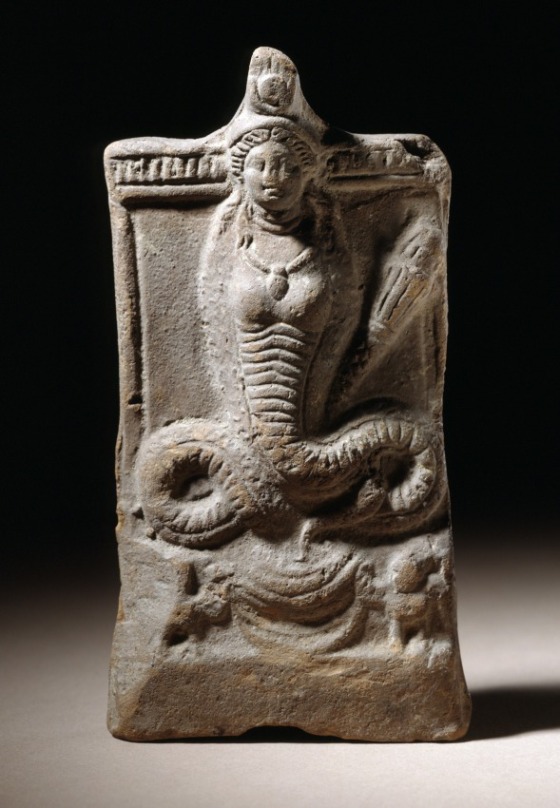
Then the Goddess entered into the mountain which we call Hout-Kâhet, and settled Herself there. After which, She went to the north and, having transformed Herself into a serpent, She entered into that mountain which is north of this nome to spy on the allies of Set as they arrived in the evening. (It is said to Her, “Hathor, Mistress of Geheset.”) The Goddess [Isis] watched the allies of Set as they arrived in the Oxyrhynchite Nome and as they crossed the country to reach Gebal, the City in the East. She pierced them all [with Her fangs since She was in the form of a serpent], and She made Her venom penetrate into their flesh, so that they perished, all together; their blood poured out upon the mountain, and this is why this mountain is called the prsh of Geheset.
The story bears a little commentary to explain some of the features. Isis is pursuing Set in revenge for His having murdered Osiris. It is interesting to note that it’s not Horus the Avenger Who is going after Set, but Isis the Avenger. I’m not sure exactly where the local Gebal is; but we are told that it is south of Dunanwi. Dunanwi is a local God of the 18th Upper Egyptian nome, so perhaps the direction refers to a temple or shrine of the God or the text is using the Deity’s name as a name for the nome itself.
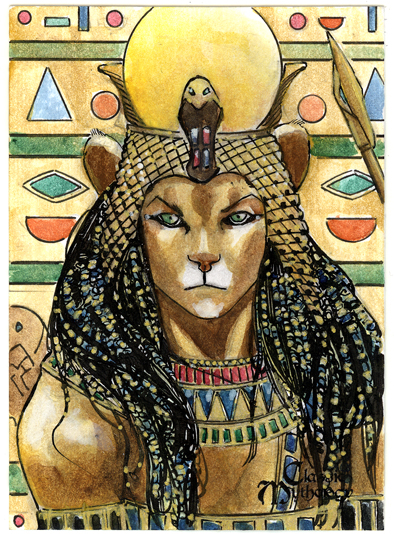
Although Isis’ first transformation is into “Her Mother” Sakhmet, Isis is repeatedly called by the name and epithets of Hathor, a local Goddess of Geheset. Geheset is a mythically powerful place; it hasn’t been conclusively identified with any real place in Egypt, but some scholars believe it may be at modern Komir, on the westbank of the Nile, south of Esna. (Interestingly, Komir was a center of the worship of Nephthys and a temple dedicated to Her has been found there. It is in the 3rd nome, however, south of the 17th and 18th nomes.) The Jumilhac papyrus does contain more information on Geheset. In another passage it says:

“Regarding Geheset, it is the temple of Hathor of Geheset, the house of the Chief of the Two Lands. House of Uraeus is the name of the Divine Booth of Hathor in this place. Isis transformed Herself into the uraeus. She hid from the companions of Set, Nephthys was there at Her side. The companions of Set passed by Her without their knowing. And then She bit them all. She threw Her two lances at their limbs. Their blood fell on this mountain, flowing, and their death happened immediately.”
Now, in the 4th nome, there was a famous Hathor cult center in Pathyris or Aphroditopolis, modern Gebelein. It is reasonably near to the Komir Nephthys temple. If this is the mythical Geheset, then Nephthys being at Isis’ (as Hathor) side makes some geographic sense.
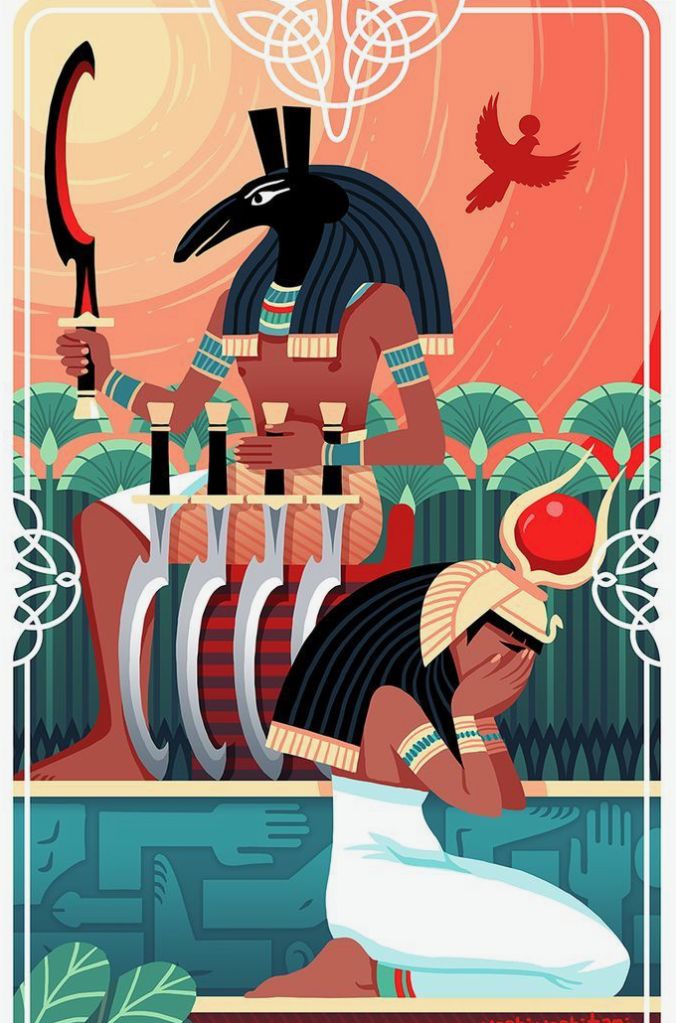
In the encounter between Isis and Set, in the form of a bull, Set attempts to rape Isis. We know this because He eventually ejaculates on the ground and Isis castigates Him for having wasted His semen like that. This reminds me of the myth in which Hephaestus tries to rape Athena, but His semen either falls on the ground or on Her leg, which She then wipes off in disgust and tosses it on the ground. The semen fertilizes Gaia and the Earth gives birth to Erichthonius, a mythical ruler of Athens who may have been part serpent. In this case, the semen of Set becomes an unidentified local plant called beded kau; the kau part is the plural of ka or vital essence.
For the final part of the tale, Isis Herself takes the form of the holy cobra, the uraeus serpent. As a great serpent, She kills all of Set’s companions with Her venom. Their blood pours out on the mountain and becomes juniper berries (prsh); there is an Egyptian pun here on juniper berries and the flowing out of blood. In another part of the Jumilhac papyrus, Isis “cut up Set, sinking Her teeth into His back” and in yet another She first transforms into Anubis, “and having seized Seth, cut Him up, sinking Her teeth into His back.” (Is there some connection between Isis transforming Herself into a dog with a knife in Her tail and later into Anubis?)

The myths recorded in the Papyrus Jumilhac are surely much earlier Egyptian stories that the priesthood used to teach their tradition in the temples of the 17th and 18th nomes. There were almost certainly other tales like these, from other nomes, in which it is Fierce Isis Herself Who takes revenge upon the murderer of Her beloved Osiris. I hope someday we will find more of them.
May the Fierce Goddess always protect you and guide your heka.
The Adma Iset: A Ritual of Offering to Isis
Are you finding it harder or easier to do your practice these days? Honestly, I go back and forth. Sometimes it seems harder, sometimes easier. But whatever the case, I know I have been needing my practice more than ever right now. We don’t have to social distance from Isis.

I often find it easier to keep up my spiritual practice when I have something “set,” something specific to do. You, too? If so, then today I’d like to offer you a simple offering ritual. (If you have my Offering to Isis, a version of it is in there. But since I hear those are going for stupid out-of-print prices, here’s a version you can use, and of course, adapt, as you choose.)
The Adma Iset
Ritual Tools: A cup or other vessel of pure water; a censer with charcoal and incense; fire starter for incense; an offering (this can be anything you choose: milk, beer, flowers, a poem, a dance); a small reed mat (such as a table placemat); a shallow tray of sand large enough to place one foot in; a bundle of fresh plants for sweeping the sand. These last two are optional, but are adapted from things they actually did in Egyptian temples. You can do this rite at your altar; I will assume you have a sacred image of Isis on your altar.
Ritual Preparation: Prepare your offering as needed; set the small reed mat on the floor before the altar; place the tray with sand and the fresh plants conveniently to the side.
Purification & Consecration
Sit comfortably before your altar, breathing slowly, clearing your mind. When you are ready, rise, approach the altar of Isis, and bow politely.
Ritualist: (Raising your hands in a gesture of adoration) Isis is all things and all things are Isis.
Take up the cup and elevate it.
Ritualist: (To the Purifying Powers) O, You Souls of Night, Water Dwellers, Purifiers, You of the Pure Water from the Sycamore Tree of Isis, I have come for you. By the Blood, by the Power, by the Magic of Isis, establish yourselves within this vessel!
Lower the cup to heart level. Visualize blue light coming into your body from above, let it move through your body into the earth, then bring it back up into your heart, then into the cup as you vibrate.
Ritualist: (Vibrating) ISET MU!
Circle your ritual space, sprinkling water, then sprinkle yourself.
Ritualist: (Speaking while walking) Isis is pure. The temple is pure. The temple is pure. I am pure. I am pure with the Purity of Isis. I am pure with the Purity of the Goddess. (Repeating until you return to the altar; then repeat as needed until you feel it to be so.)
Ritualist: By the Magic of Isis, it is so!
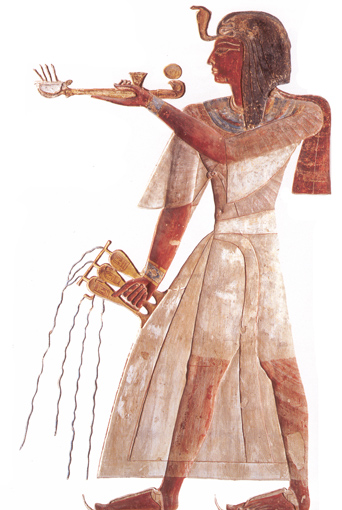
Return cup to altar, take up censer and elevate it.
Ritualist: (To the Consecrating Powers) O, You Souls of Day, Fire Dwellers, Consecrators, You of the Pure Breath from the Mouth of Isis, I have come for you. By the Blood, by the Power, by the Magic of Isis, establish yourselves within this censer!
Lower the censer to heart level. Visualize red light coming into your body from above, let it move through your body into the earth, then bring it back up into your heart, then into the censer as you vibrate.
Ritualist: (Vibrating) ISET ASH!
Circle your ritual space, censing it and then yourself.
Ritualist: (Speaking while walking) Isis is consecrated. The temple is consecrated. The temple is consecrated. I am consecrated. I am consecrated with the Fire of Isis. I am consecrated with the Flame of the Goddess. (Repeating until you return to the altar; then repeat as needed until you feel it to be so.)
Ritualist: By the Magic of Isis, it is so!
Entering

Face the altar and make the Gesture of Adoration.
Ritualist: Isis is upon Her Throne. The spirits awaken! They awaken in peace for they know that I have come to make offering unto this Great Goddess.
Put your palms together and extend your arms straight out in front of you. Slowly open your arms as if opening a heavy curtain. This is the gesture of Opening the Shrine. Place the tray of sand before the sacred image and step in it to leave a footprint in the sand.
Ritualist: The sacred doors are opened to me. The light goes forth. It guides me on a fair path to the place where the Great Goddess is. I approach Your shrine, O Isis.
Offering to the Uraeus Goddess
Take up the censer and elevate it.
Ritualist: (Addressing the Uraeus serpent form of Isis) The Sacred Eye is powerful. Lady of Flame, Great One Who is between the horns of the Sunshine Goddess, accept this perfume and let me enter in peace.
Place the censer in your dominant hand, resting on your upturned palm. Bring that hand to your heart. Breathe in and visualize light glowing around the censer. Slowly swing your arm outward toward the image of the Goddess. Visualize the light flowing from the incense smoke to Her sacred image. This is the Gesture of Giving. Return the censer to its place.
Invoking the Goddess

Stand before the sacred image. Place your palms together in front of you. Bring them apart to a comfortable distance, remaining thumbs up. To make the Gesture of Invocation, move the tips of your fingers towards you in a ‘come to me’ gesture. Do this slowly and gently as you speak the invocation below.
Ritualist: Iu en-i. Iu en-i (Eeoou-en-EE). Come to me, come to me, Beautiful, Great One—Isis of Many Names, Lady of Sacred Magic, Great Mother, Great Goddess, come to me, come to me! (Vibrating) ISIS. ISIS. ISIS.
See within your heart the light of the Goddess. Feel it glowing with sun-bright warmth and beauty.
(Speaking to the Goddess) Fair is Your coming to Your temple, Isis. Beautiful is Your appearance in my heart.
Place your hand upon your heart, breathe in, and on the out-breath, move your hand toward the altar and send that light into the sacred image of Isis.
Making Offering

You may wish to be seated at this time.
Ritualist: My body being on Earth, my heart being awake, my magic being in my mouth, O Isis, I make offering unto You.
Take up your offering. With open heart, speak aloud why you have chosen to give that particular offering to the Goddess.
If your offering is physical, use the Gesture of Giving (above) to offer it to Isis. If it is not, visualize a symbol representing it in your palm as if it were physical. Breathe in, visualize light around the offering, then on the out-breath, move your hand toward the altar and see that light transfer to the sacred image of Isis. Then, if your offering is performative, perform the offering (e.g. read the poem, dance the dance).
Closing the Temple
Once again, take some time to see the light of what you have given glowing around the sacred image of Isis. Let yourself KNOW that She has accepted your offering. Feel Her blessing upon you in return.
When you are ready, take up the bundle of plants and sweep away the footprint in the sand. Make the Gesture of the Closing of the Shrine (the opposite of Opening the Shrine above).
Ritualist: I have flourished on water. I have grown on incense. I have climbed up on sunbeams. O Isis, give me Your hand for I have made offering unto You.
Be in peace, Isis, be in peace. Amma, Iset (AH-ma, EE-set; Egyptian: “Grant that it be so, Isis”).
The Adma is finished. Exit the ritual space or remain in meditation as desired.

Meta-Addiction: The Issue Underlying Self-Sabotage
Meta-Addiction: The Issue Underlying Self-Sabotage
What IS An Earth Healer?
What IS An Earth Healer?
Talking with Isis
When we connect with Isis, how do we do that? Prayer? Meditation? Invocation? Visualization? Can we talk with Her, actually have a back-and-forth conversation? Can we ask Her questions? Can we request Her help?
Yes, we can. How exactly you do it is up to you. And perhaps, with this required downtime we’re all going through right now, you’ve discovered (or rediscovered) the ways that work best for you.
My own boundaries between prayer, meditation, and visualization tend to be rather soft. Very often, I find that meditation flows into visualization flows into prayer flows into an offering chant flows back into meditation. Sometimes I visualize the whole time, sometimes I don’t “see” anything, but just feel Her presence. Sometimes I can “hear” Her voice, sometimes I just sense in some way what She is communicating with me.

Here’s a perfect image for ‘ascending’ in your visualizations…indeed, the pillars in Egyptian temples were meant to be holding up the sky.
But why do we talk with the Goddess, why do we strive to “see” Her? There is a point and it’s not just an ego boost.
The point of this sort of talking with the Goddess is communion—sharing with Her in one way or another and asking Her to share with us. Sometimes we just need the reassurance that She is there, so we invoke and try to sense Her. Sometimes we need help, so we ask for it. Sometimes we are so full of love for Her that we simply must express it.

Talking with Goddess is good for our souls and spirits, too. I think that Iamblichus, my favorite Neoplatonic theurgist, had it right: invocation of the Deities lifts up the soul of the theurgist (or Isis devotee, in this case) and brings us closer to the Divine. By repeatedly connecting with Isis—whether through prayer or ritual or devotions, meditations or visualizations, dance or chanting, or any number of other ways—we make ongoing contact with the Divine.
The more we come into the presence of Holy Isis, the more we become infused with Her holiness. In the same way that we tend to mirror the people with whom we spend the most time, spending more time with the Divine can help us better mirror that Divinity, and can help to make us better people.

Of course there are ways we can make some serious missteps in this process. The most problematic is when we think we’re talking to Isis, but we’re actually talking to ourselves; when it’s not Isis Who we hear in our heads, but only our own subconscious echoes.
That’s what I think happens with some of the mega-church preachers who always seem to hear God asking for more money or with church-based hate groups who think they hear God condemning everyone but themselves. They’re not talking to the Divine; they’re getting feedback from their own interior bullshit. This can happen to people with even the best of intentions. I know it’s happened to me; chances are, if you’re talking with Isis, it will or already has happened to you, too.
So what do we do about it?

Unfortunately, there’s no easy answer, no perfect solution, no quick fix. The only partial answer that I know of is to develop spiritual maturity. A spiritually mature person will be better able to recognize their own internal “stuff,” and so be better able to separate it from true Divine contact with Isis. Did Isis really say that so-and-so with whom I had a fight yesterday deserved a big, fat comeuppance? Nope; pretty sure that was me and not Her. She, on the other hand, might offer advice on how I can get over it or She might even point out that I need to make an apology.
The other tricky thing about all this is that while we live in these bodies, we will never—I repeat, never—receive pure and unadulterated contact with the Divine. It comes to us though our own perceptions of body and mind. There is no other path the Divine can use. While we are incarnate beings, the Goddess must come to us through our perceptions—and our perceptions are always, always, always tinged by our own psychological makeup. That’s not necessarily a bad thing. In fact, getting to know our own psychology is very valuable in sorting all this out. It’s just something that is and we have to be aware of it if we hope to hear—in the clearest voice possible—what Isis has to say.
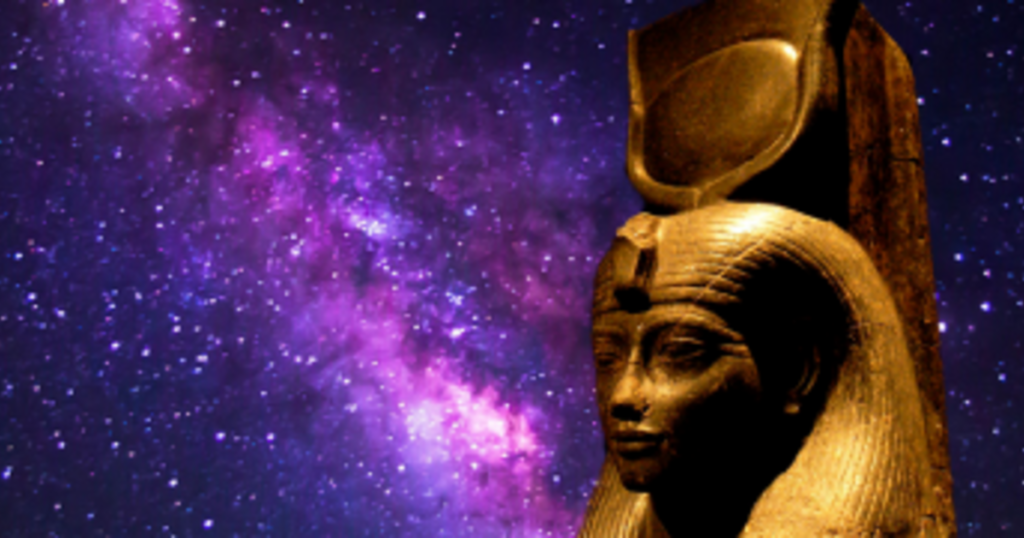
The one clue I can offer, after many years of wrestling with my own head and heart, is that when it is truly Her—as opposed to just my echo chamber—the thought-impression-feeling-intuition I get seems to come suddenly and without precedent. I can recognize it as “not-me” (or not just me). Sometimes the words are strange or the images are not ones I would normally choose. Yes, it’s all very subjective—which is my point exactly. That’s why the more you know about yourself, the more you can move yourself out of the way so that you can better know when it is Isis Who is doing the talking.








